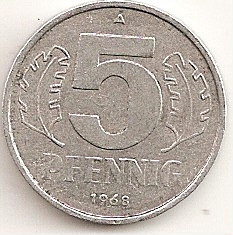Deutsche Demokratische Republik (Erstwhile East Germany) coins
Recently, I came across four coins (two mark and pfennigs) from Deutsche Democratic Republik –DDR-(old East Germany), which were given to me by my brother-in-law who had actually been in DDR in the 1950s/1960s and used these coins. These coins were called DDMs (or “Mark Der DDR", in German) or simply the “Eastern marks” (“OstMark’ in German).
The nomenclature for these issues (both currency and coins) was different at different times:
From 1948 to 1964, the currency was called ‘Deutsche Mark”.
From 1964 to 1967, it was called “Mark der Deutshen Notenbank”
From 1968 to 1990 (the year of the German Unification), the currency was called “Mark der DDR”.
However, at all times of its issue, the Mark continued to consist of 100 pfennigs.
It is interesting to note, that the value of the DDR currency, although having equal value as the Bundesrepublik Deutschland Deutsche mark (West German Mark) within the East German territory, was rendered worthless outside East Germany, due to convertibility issues. Thus, it is interesting to note, that, if one managed to go to West Germany for a visit from East Germany, one had to rely on friends and relatives for meeting attendant expenses for the visit.
Upon the unification of Germany on 1st July 1990, as a result, substantial subsidies were built into the exchange rate of the East German Mark, to facilitate the citizens sustain their livelihood and for letting East German businesses ,compete up with their west Germany counterparts.
The following denominations were introduced in East Germany at various times:
One, five and ten Pfennigs:1948 onwards, composition Aluminium.
50 Pfennigs : 1950; composition Aluminium-bronze. Later,in 1958; the composition was switched to Aluminium.
One Mark : 1956; composition Aluminium.
Two mark : 1957: composition Aluminium.
20 Pfennig : 1969; composition Brass.
Five mark : 1968; nickel-bronze and, later, cupro-nickel
Let us see what coins I have got hold of.
The first one is a circular/ round two-mark from 1957. Bingo! From the above chart, it is clear, that this coin is one of the first issues , as minting of these coins was undertaken in 1957 itself. It is made of Aluminium, weighing 3.00 gms or 0.106 ounce. Its size is 1.603 inches or 27mm , thickness is 2.3 mm. The edge is milled.
On the obverse are hammer and a compass symbols , which represent probably, worker’s tools . There is a border design around the symbols, probably an oak symbolism, outside which the words “Deutsche Democratische Republik” is mentioned.
On the reverse is written 2 Deutsche mark, year of minting, 1957, and two leafs each on either side of the numeral “2”. There is a mint mark "A" on top of the numeral "2" . This is the Berlin mint mark in these early issues.
The second coin is also round/circular. Its denomination is 50 Pfennig from 1968. This coin is from the series whose composition is entirely Aluminium minting of which commenced in 1958. The obverse design is the same as the two mark coin. The weight is 2 gms. , diameter is 23 mm, thickness is 2.1mm. The edge is milled.
Obverse of the 50 Pfennig coin, 1968.
On the reverse , the numeral “50” appears with the words “pfennig” below the numeral. A leaf appears on top of the numeral .The mint mark although "A" on top of the numeral "50" has been adopted by the Leningrad mint, for the purpose of maintaining similarity in the coin issues.
The third coin is a 5 Pfennig from 1968, which were made in Aluminium from 1958 onwards. It has the same design on the obverse and reverse as the 2 mark coin. Its weight is 1.1 gm, diameter is 19mm, thickness is 1.9 mm. The edge is smooth.
Obverse of the 5 Pfennig coin, 1968.
Reverse of the 5 Pfennig coin from 1968. It also has an "A" mark on top of the numeral "5", but the coin is issued from Leningrad mint.
The last coin is a “1” Pfennig from 1968 , is made of Aluminium from 1948 onwards, and has the same features as the 5 Pfennig coin above. Its weight is 0.75 gms, diameter is 17mm and thickness is 1.5 mm. The edge is smooth.
Obverse of a 1968 1 Pfennig coin.
Reverse of the 1 Pfennig coin from 1968, again minted at Leningrad mint.
(Coin catalogues do not attribute much value to these coins and like most modern coins are worth face value. Nevertheless, the contribution of these coins to the historical development of Europe cannot be undermined.)
Links to posts on Federal Republic of Germany issues and other posts on this blog:
Germania Mint issues:
Links to posts on Austrian Mint Coin issues on this blog:
Magic of Gold 100 Euros Gold Coin Series:
Alpine Treasures Coin Series:
For posts on COTY (Coin of the Year) winners since 2015 in a competition held by Krause Publications of Germany, please visit the following links:
For some other interesting posts from Italy/The Vatican, please visit the following links:








i have this coin please contact me
ReplyDeletei want to sale
anuj jain
09893048930
+919893048930
anuj.master.mlm@gmail.com
Your article is very nice and please share article on ms in germany for indian students for the ui ux design course in germany
ReplyDeleteYour article is good. please provide more information of ui ux design course in germany and Best University in Germany for Masters so that it will help for MS in Germany for Indian Students.
ReplyDelete